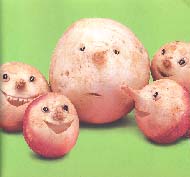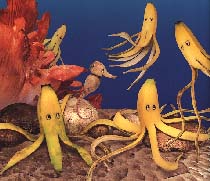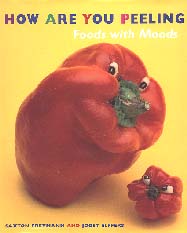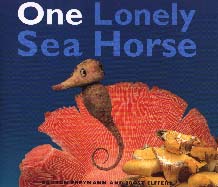|
________________
CM . . . .
Volume VII Number 3 . . . . October 6, 2000
excerpts: A Note About the Art  Fortunately for young readers, Freymann and Elffers, as they grew up, did not listen to their
parents' admonitions about not playing with their food for sculptures constructed entirely of fruits
and vegetables are the basis of both books. In How Are You Peeling?, with just a few cuts to
the surfaces of fruits and vegetables, plus taking advantage of the produces' natural folds, creases
and colours, the creators provide "heads" whose faces display a wide variety of emotions. Usually
the brief text requires the viewer to identify the emotion being portrayed. For example, the reader
is asked, "How are you when friends drop by?" and then the illustrations offer a variety of
scenarios: "With someone new ... a little shy? (A smiling head facing a melon-based turtle); "Don't
belong? (An apprehensive looking lemon isolated on a page by itself and then, on the facing page,
smiling and surrounded by a gang of other smiling lemons); or "Feel insecure" which shows five
smiling onions, their roots cropped to look like brushcuts, "standing" next to a most anxious
looking onion, its roots forming a wild tangle of hair. The book is a fun way for young children to
expand their "emotional" vocabulary while exploring the spectrum of feelings displayed on the
fruit/vegetable faces. Unfortunately, Freymann and Elffers do not provide a key to their art's raw
materials, and likely several of the fruits and vegetables will be unknown to some readers, both
young and old.
Fortunately for young readers, Freymann and Elffers, as they grew up, did not listen to their
parents' admonitions about not playing with their food for sculptures constructed entirely of fruits
and vegetables are the basis of both books. In How Are You Peeling?, with just a few cuts to
the surfaces of fruits and vegetables, plus taking advantage of the produces' natural folds, creases
and colours, the creators provide "heads" whose faces display a wide variety of emotions. Usually
the brief text requires the viewer to identify the emotion being portrayed. For example, the reader
is asked, "How are you when friends drop by?" and then the illustrations offer a variety of
scenarios: "With someone new ... a little shy? (A smiling head facing a melon-based turtle); "Don't
belong? (An apprehensive looking lemon isolated on a page by itself and then, on the facing page,
smiling and surrounded by a gang of other smiling lemons); or "Feel insecure" which shows five
smiling onions, their roots cropped to look like brushcuts, "standing" next to a most anxious
looking onion, its roots forming a wild tangle of hair. The book is a fun way for young children to
expand their "emotional" vocabulary while exploring the spectrum of feelings displayed on the
fruit/vegetable faces. Unfortunately, Freymann and Elffers do not provide a key to their art's raw
materials, and likely several of the fruits and vegetables will be unknown to some readers, both
young and old.

One Lonely Sea Horse is a 1-10 counting book which tells the story, via rhyming couplets, of Bea, a little seahorse who was blue because she thought she was all alone in "the cold and salty sea." With each turn of the page, readers meet new sea creatures who are willing to be Bea's friends. In turn, Bea encounters two small crabs, three puffer fish and so on through 10 angelfish. Finally, Bea can happily announce: "You are my friends," said Bea, "that's true, And I can always count on you!" What sets this counting book apart from others are the truly amazing underwater, double page spread seascapes which viewers gradually come to realize are constructed entirely of fruits and vegetables. Bea is constructed of two chioggia beets while, for instance, the lobsters are ginger, the puffer fish are horned melons and the dolphins are bananas. The sea's bottom is covered with such things as kale "coral" and rutabaga, potato and mushroom "rocks" while chive and fava bean "seaweed" waves in the water. The book's closing end papers provide a most useful visual key to the various fruits and vegetables that were used to construct the underwater scenes. Certainly both books, in addition to being just fun viewing and reading, would make excellent additions to art classes as stimuli to creativity. Highly Recommended. Dave Jenkinson teaches courses in children's and adolescent literature in the Faculty of Education at the Faculty of Education, the University of Manitoba.
To comment on this title or this review, send mail to cm@umanitoba.ca.
Copyright © the Manitoba Library Association.
Reproduction for personal use is permitted only if this copyright notice
is maintained. Any other reproduction is prohibited without
permission.
Published by
TABLE OF CONTENTS FOR THIS ISSUE - October 6, 2000.
AUTHORS |
TITLES |
MEDIA REVIEWS |
PROFILES |
BACK ISSUES |
SEARCH |
ORDER |
CMARCHIVE |
HOME
|

